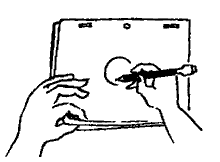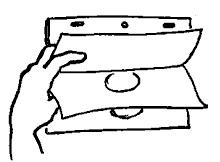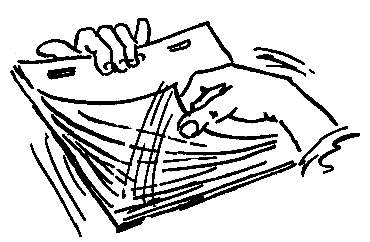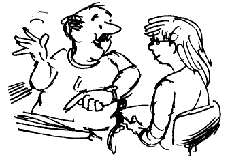 |
|
||
|
How an Animator Works |
|||
|
The director explains the nature of the sequence. He makes suggestions as to the playing of the scene and gives the animator the story board, character models, exposure sheets and the necessary portion of the soundtrack. Using the doodles as a guide the animator roughs in the action over the background layout. Details are not important at this stage, only the large masses. As the animator works, one drawing is flipped against another. By flipping or rolling five drawings at a time, the animator checks for actions that lack emphasis. Like a sculptor with clay, the animator makes slight adjustments, extending a character's arm or exaggerating a pointing toe. Any drawings that weaken the action are discarded. The animator must also decide how much squash and stretch to put into the action and if effects such as flashes, smoke or speed lines would enhance or detract from it. |
|||
|
Once a series of drawings is roughed in, the animator numbers them and indicates them on the exposure sheet. Throughout the roughing in stage, the animator refers to the storyboard and the layouts and listens again and again to the soundtrack. This continues till the scene is completed and all the drawings and camera instructions have been written clearly on the exposure sheet. In brief, the work of a competent animator reveals these qualities: •The presence of rhythm and weight in each action. • Normal movements, like speaking, hands tying a shoelace, a figure climbing a ladder and such, appear believable. • Purposeful distortion of shapes. • Effective timing. • Economical number of drawings. • Clearly-stated, systematic instructions for those who do the follow-up work. |
|||
   |
|||
|
|
|||
|
|

 The animator studies the storyboard and the layouts, listens to the track many times and asks, "What makes this scene unique? Is this the only way to stage the action? What is the high point of the scene?" By making several thumbnail doodles the animator finds the poses that work the best while discovering any hidden technical problems in scale or perspective.
The animator studies the storyboard and the layouts, listens to the track many times and asks, "What makes this scene unique? Is this the only way to stage the action? What is the high point of the scene?" By making several thumbnail doodles the animator finds the poses that work the best while discovering any hidden technical problems in scale or perspective.